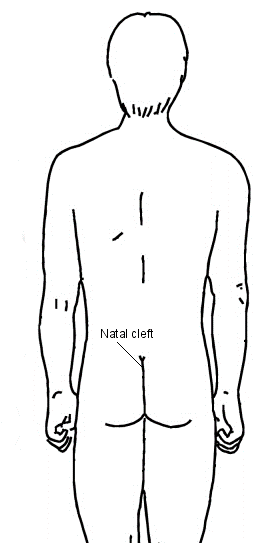Pilonidal Sinus
A pilonidal sinus is an infected tract under the skin between the buttocks. Treatment commonly involves an operation. After the operation you should keep the area free of growing hair by regular shaving or other means of hair removal.
What is a pilonidal sinus?
- Pilonidal means a 'nest of hairs'.
- A sinus tract is a narrow tunnel (a small abnormal channel) in your body. A sinus tract typically goes between a focus of infection in deeper tissues to your skin surface. This means that the tract may discharge pus from time to time on to your skin.

What are the symptoms of a pilonidal sinus?
A pilonidal sinus may not cause any symptoms at first. You may not be aware that you have one. Some people notice a painless lump at first in the affected area when washing. However, in most cases, symptoms develop at some stage and can be 'acute' or 'chronic'.
Rapid-onset (acute) symptoms
You may develop increasing pain and swelling over a number of days as a ball of pus with surrounding skin infection (an infected abscess) develops in and around the sinus. This can become very painful and tender.
Persistent (chronic) symptoms
Around 4 in 10 people have a repeated (recurrent) pilonidal sinus. You may develop some pain which is less intense than the acute symptoms. Usually the sinus discharges some pus. This releases the pressure and so the pain tends to ease off and not become severe. However, the infection never clears completely. This can mean that the symptoms of pain and discharge can last long-term, or flare up from time to time, until the sinus is treated by an operation.
What is the treatment for pilonidal sinus?
Video Assisted Laser Ablation of the Sinus tract:
In this method of treatment, a special VAAFT scope is used to visualize the sinus tract and along with that all the debridement, infected material removal and all hair removal is done using the Video endoscope and after that, a laser beam is used to ablate the entire tract and lead to resolving of the sinus tract.
Wide excision and healing by secondary intention.
This operation involves cutting out (excision of) the sinus but also cutting out a wide margin of skin which surrounds the sinus. The wound is not closed but just left open to heal by natural healing processes (healing by 'secondary intention'). This usually requires several weeks of regular dressing changes until it heals fully. The advantage of this method is that all inflamed tissue is removed and the chance of the condition coming back (a recurrence) is low.
Excision and primary closure.
This means taking out the section of skin which contains the sinus. This is done by cutting out an oval-shaped (ellipse) flap of skin either side of the sinus, which takes out the sinus. The two sides of the ellipse are then stitched together. The advantage for this is that, if successful, the wound heals quite quickly. The risk of a recurrence or of developing a wound infection after the operation is higher than with the above procedure. This risk may be reduced by using a wound technique in which the line of stitches is moved away from between the buttocks.
A plastic surgery technique.
In some cases, where the sinus recurs or is extensive, plastic surgery may be advised to remove the sinus and refashion the nearby skin. Which is called a Flap Surgery.